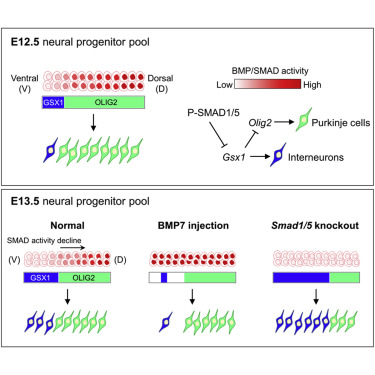Cell Reports ( IF 7.5 ) Pub Date : 2020-03-17 , DOI: 10.1016/j.celrep.2020.02.089 Tsz Ching Ma , Keng Ioi Vong , Kin Ming Kwan

|
Neural progenitors undergo temporal fate transition to generate diversified neurons in stereotyped sequence during development. However, the molecular machineries driving progenitor fate change remain unclear. Here, using the cerebellum as a platform, we demonstrate that the temporal dynamics of a dorsoventral bone morphogenetic protein (BMP)/SMAD signaling gradient orchestrates the transition from early to late phase of neurogenesis. Initially, high BMP/SMAD activity in cerebellum neural progenitors transcriptionally represses the late-born interneuron fate determinant Gsx1. As development proceeds, gradual decline in SMAD activities from ventral to dorsal progenitors progressively alleviates suppression on Gsx1 and allows transition of progenitor fate. Manipulating the BMP signaling dynamics can either lead to an immediate halt or rapid acceleration of the temporal fate switch, thus unbalancing the generation of distinct neuronal populations. Our study thus demonstrates that neural progenitors possess inherent competence to produce late-born neurons, yet identity transition is mechanistically executed by precisely timed and positioned reduction of repressors for late-fate determinants.
中文翻译:

神经祖细胞中BMP信号传导活动的时空下降介导命运的转变,并保障神经发生。
神经祖细胞经历暂时的命运转变,以在发育过程中以定型序列产生多样化的神经元。然而,驱动祖细胞命运改变的分子机制仍然不清楚。在这里,使用小脑为平台,我们证明了背腹骨形态发生蛋白(BMP)/ SMAD信号梯度的时间动态协调从神经发生的早期到晚期阶段的过渡。最初,小脑神经祖细胞中的高BMP / SMAD活性转录抑制晚期出生的神经元命运决定因素Gsx1。随着发育的进行,SMAD活动从腹侧到背侧逐渐减少,逐渐减轻了对Gsx1的抑制并允许祖先命运的过渡。操纵BMP信号动力学可能会导致瞬时命运切换立即停止或迅速加速,从而使不同神经元种群的产生失去平衡。因此,我们的研究表明,神经祖细胞具有产生晚出生神经元的固有能力,而身份的转变是通过精确确定时间和位置的抑制子来确定迟发决定因素的机制而执行的。











































 京公网安备 11010802027423号
京公网安备 11010802027423号